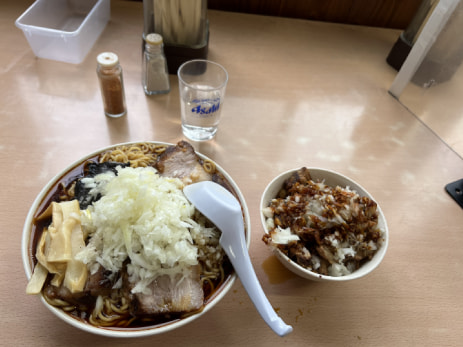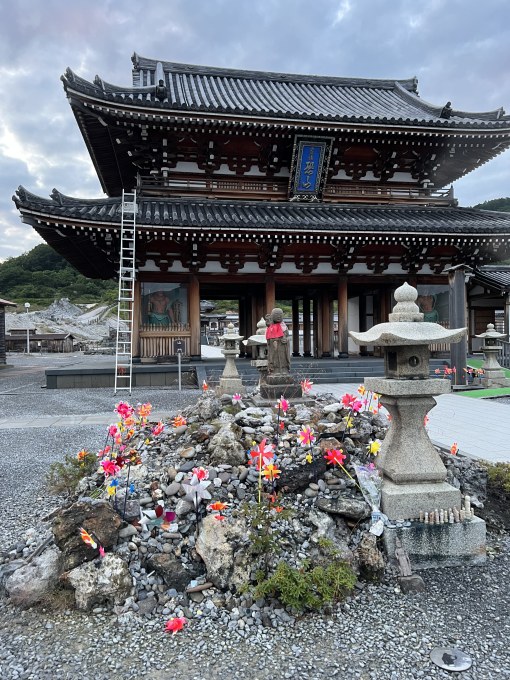Umenoya(梅乃家) has been long loved by local people in Takeoka(竹岡), Boso(房総) peninsula, south wedge of Chiba(千葉) prefecture.

Many of you, foreign tourists in Japan, may not know the shop well, but you could become addicted to its taste once you try it.
Small, but famous ramen shop which has been running for many decades
Umenoya is a small, but locally famous ramen shop.
Also, it has a long history: as far as I know Umenoya started running just before or after WWⅡ(ended in 1945).
Since its start-up, the ramen shop has been running at the same place and cooked the ramen in the same style.

Umenoya is a ramen shop at Takeoka of Futtsu city, Boso penninsula in Chiba prefecture.
It began about eight decades ago alongside route 127, attracting a large number of local people for its rich soy-source flavor ramen.
You can see a piece of red cloth in front of the house, which is the sign of “open”.
What’s the feature of Umenoya’s ramen?
And what’s the feature of Umenoya’s ramen?
Compared with other shops’ ramen, what’s the difference?
Yes, the shop doesn’t use raw noodles(生麺). So, it’s as if this were instant ramen!

I usually order these two menus: large-portion ramen topped with minced onion, and chashudon(チャーシュー丼), bowl of rice topped with chopped chir su and micned onion, and seasoned sweet soy sauce.
“No kidding! Such ramen cannot compete with ordinary ramen served at other ramen shops!”
Some may think this way.
However, I’m sure the fact does not necessarily negate Umenoya. As the proof, Umenoya has been proud of its great popularity for many decades by cooking the ramen.
As you may know from the picture above, the ramen takes on kind of rough appearance. The reason seems mainly to be that the ramen shop was originally started for nearby local people, most of whom were fishermen: generally they like rough-looking, but large potions. I guess their such taste led to Umenoya’s ramen style and since then the ramen shop has still been keeping the style.
Even though the china bowl(丼) seems kind of old and small, the portion is large!
Even in an ordinary ramen, there is the soup just at the edge of the bowl: you’ll have trouble running over the soup from the bowl.
And it’s taste is amazing!
In dark, rich soy-source flavored soup, the chewy noodle can match the soup very well. Once you take a bite, the noodle will dance in your mouth along with the soup’s flavor!

The menu is very simple: Umenoya basically serves only ramen, chashumen, and their large portions(大盛り).
In fact, the flavor is such that when you are in front of Umenoya, or even when you drive a car through the ramen shop, you must be overwhelmed at the flavor, forced to enter the shop!
There is one drawback to remember when you try Umenoya?
However, there is one thing you should also know as its drawback. It is that the ramen, much more chashumen(Char siu noodles チャーシュー麺), has too oily. I guess this problem comes from the thick char siu(チャーシュー、焼き豚).
To solve this trouble, I recommend you should order to add yakumi(薬味) to your ramen. Although this is another order, yakumi is a portion of minced onion and can push away the oiliness of char siu. So if you feel char siu is too oily, you should eat some yakumi(another order) with it.

Every time I eat ramen here at Umenoya, I always add to order yakumi topped.
This way I can keep enjoying his ramen without any trouble with oily content.
Umenoya competes on only its ramen with other ramen shops
Many of foreign tourists, who are familiar with ramen in Japan, however, may imagine any ramen shop will also serve other food like gyoza, chahan(fried rice、チャーハン(炒飯)), and the like.
However, Umenoya basically serve only ramen and chashumen(Char siu noodles チャーシュー麺).
Besides, if any, you can eat chashudon(チャーシュー丼)、bowl of rice topped with chopped chashu(roasted pork), seasoned with minced onion and sweet soy source.
And you can also enjoy there beer and Japanese liquor.
But that’s all: it can be said the shop has been competing basically on only ramen with other ramen shops in the neighborhood until now!

You can see in this menu at Umenoya only ramen, chashumen, large portion of both, bowl of rice, chashudon, and some drinks: the shop owner seems to have enough fixed confidence in their taste.
《Caution!》
Each price in the menu above can be changed anytime: you should always keep the information updated!
《Business time》
10:00~18:00(Monday, Thursday, and Friday)
10:00~17:00(Saturday, Sunday, and holiday)
Closed on Wednesday
※The shop also closes as soon as sold out
Why doesn’t Umenoya serve other dishes like gyoza, chahan, or others which we can experience at other ramen shops?
I guess there are three reasons.
Firstly, the present owner still respects his predecessors.
As I told above, Umenoya began running about during WWⅡ, but as loosing the war, there were a small number of foods, a tiny amount of ingredients in Japan. And so people sometimes starved to death. At that time they couldn’t come up with cooking gyoza, chahan or other dishes than ramen, which was perhaps rather easy to cook.
I hear the first owner was an old lady, who was a relative to the present owner.
Secondly, the owner of Umenoya has great pride and confidence in his work. In his book published about 3 decades ago, he says, “I’m cooking ramen at the risk of my life.”
He must be concentrating on only cooking ramen instead of other dishes.
Also, there seems to be no need to add other menu at Umenoya, mainly because the ramen shop has been enjoying consistent popularity for a long time in the neighborhood only for ramen: at noon, you can always see a long customers’ line in front of the shop.
Gaining only modest reputation though called “one of Chiba’s three great ramens”?
If you take good care of looking into ramen-related articles in some Japanese magazines, you can find Umenoya is famous as “one of Chiba’s three great ramens(ramen shops)”.
However, many magazines related to ramen and ramen shops in Chiba prefecture don’t seem Umenoya is highlighted so much.
This may be because the shop is seemingly rather outdated or somber in its appearance.

This is the inside of Umenoya.
Its tables and cheirs, including the toilet, are rather old: from this interior, you may associate many stalls you can see outdoors.
As I told above, Umenoya basically serves only ramen and chashumen, and its house has a small, old appearance.
The inside of the shop is the same, although during the busy hours like noon, the inside becomes full of many local people and tourists. you may often find a group of bike riders occupying the space.
“Takeoka ramen” means Umenoya
However, you may also find the name “Takeoka ramen(竹岡ラーメン)” or “Takeokashiki ramen(竹岡式ラーメン、ramen prepared in Takeoka way)” when you try to access some ramen shops in Chiba prefecture. These are all originated in Umenoya and Suzuya(鈴屋), two ramen shops in Takeoka town: the latter is also a locally popular ramen shop, located alongside route 127, just about a few km north to Umenoya.
I’d like to say that if you know Umenoya, you’ll have different experience from other ramen shops, and your ramen-life could change.
How to access Umenoya?
I must say the location of Umenoya is somewhat inconvenient to access: it’s a rural area of Futtsu city in Chiba prefecure.
If you want to access there, you have to take JR train and the bus.
The way to Umenoya from Tokyo JR station is below.
If you go to Umenoya from Tokyo station, take Sobu(総武) Kaisoku(快速 rapid) for Narita or Chiba station at the 3rd basement of the station and change trains at Chiba station. You should take Uchibo line(内房線) there and go to Kazusaminato station.
Or take Keiyo line(京葉線) at Tokyo station and go to Soga(蘇我) station(Keiyo line’s last stop), and change trains to Uchibo line to go to Kazusaminato station.
And then take the bus for Hamakanaya(浜金谷), just near Kazusaminato station.
Get off at Juyaji(十夜寺) bus stop in Takeoka town.
You can see Umenoya(the picture above) just across route 127.
Also, if you drive a rented car, you can use the parking lot below.






